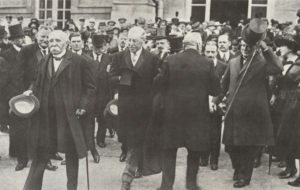June 28, 1919 Treaty of Versailles and Protection of Minorities
 June 28, 1919 Treaty of Versailles and Protection of Minorities
June 28, 1919 Treaty of Versailles and Protection of Minorities
The Germans, even before the Versailles of Jewish Minorities in Poland Treaty was completed, were preparing to argue the case for minority rights to protect Germans living outside of Germany’s borders. After the rejection of proposals to include the protection of minorities within the Covenant of the League of Nations itself, the minority issue was finally directly and separately addressed. Dominated by its British and American members, the committee drafted model minority treaties, first for Poland and then for 12 other Countries. Despite bitter protests from their representatives, the Polish government, as a condition for recognition, had to grant in Articles 1—8 complete “protection of life and liberty to all inhabitants” regardless of “birth, nationality, language, race or religion” and to guarantee the free exercise of any “creed, religion or belief” not inconsistent with public order or public morals.
Article 9 laid down that the “Jewish communities of Poland” could establish educational committees of their own choosing and would receive a share of public funds, while Article 11 guaranteed that the Jewish Sabbath was to be respected and not used as a weapon against the Jews.
By 1924 Albania, Austria, Bulgaria, Czechoslovakia, Estonia, Greece, Hungary, Latvia, Lithuania, Romania, Turkey, and Yugoslavia had recognized minorities as collective entities and had agreed to respect their “national rights.” Upper Silesia and, in 1932, Iraq were added to the list. The special clauses relating to the Jews were not included in the other minority treaties.
Source: Carole Fink, “The Minorities Question at the Paris Peace Conference: The Polish Minority Treaty, June 28, 1919,” in Boemeke, Feldman, and Glaser (eds.), The Treaty of Versailles, 269-70.



